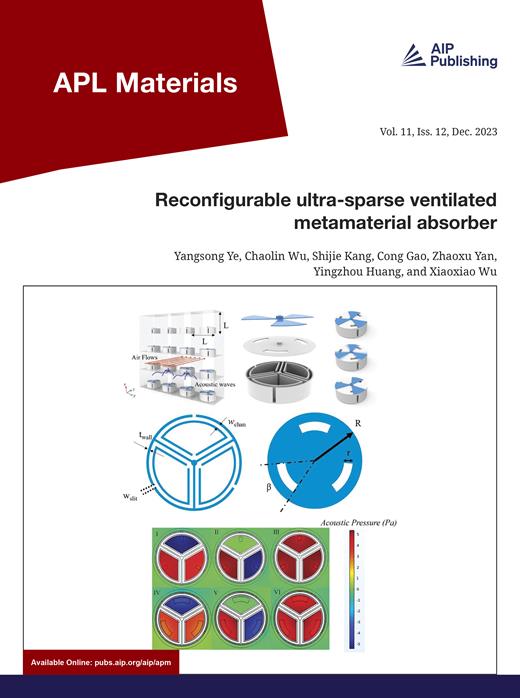量化轨道拉什巴-爱德斯坦效应对磁化有效阻尼扭矩的巨大贡献
IF 5.3
2区 材料科学
Q2 MATERIALS SCIENCE, MULTIDISCIPLINARY
引用次数: 0
摘要
作为现代自旋电子学核心的大自旋电流和相关自旋转矩的产生,长期以来一直是通过电荷-自旋转换机制(即自旋霍尔效应和/或拉什巴-爱德斯坦效应)实现的,这与强自旋轨道耦合有着内在联系。最近,人们预测并观察到了一种新的途径,即通过轻元素(因此具有弱自旋轨道相互作用)实现显著的电流诱导转矩。这些发现指出了电子轨道对应物的潜在参与,即轨道霍尔效应和轨道拉什巴-爱德斯坦效应。在本研究中,我们旨在量化这些轨道效应对不同体系中作用于 Co 薄层的有效转矩的贡献。首先,我们证明了在 Pt|Co|Cu|AlOx 堆叠中,Cu|AlOx 界面的轨道 Rashba-Edelstein 效应和底部 Pt|Co 系统的有效自旋霍尔效应所产生的转换扭矩强度相当。其次,为了放大轨道到自旋的转换,我们研究了 Co|Pt|Cu|CuOx 中中间铂层的影响。通过谐波霍尔测量以及自旋霍尔磁阻和太赫兹光谱实验确定的有效转矩的铂厚度依赖性,我们证明了在 Cu|CuOx 界面存在着巨大的轨道拉什巴-爱德斯坦效应,从而导致在最佳铂厚度下 Co 上的净转矩增强了两倍。我们的发现不仅证明了轨道电流在自旋轨道耦合较弱的低维系统中可以发挥关键作用,而且揭示了轨道电流可以在自旋电子器件中实现更高效的磁化操纵。本文章由计算机程序翻译,如有差异,请以英文原文为准。
Quantifying the large contribution from orbital Rashba–Edelstein effect to the effective damping-like torque on magnetization
The generation of large spin currents, and the associated spin torques, which are at the heart of modern spintronics, has long been achieved by charge-to-spin conversion mechanisms, i.e., the spin Hall effect and/or the Rashba–Edelstein effect, intrinsically linked to strong spin–orbit coupling. Recently, a novel path has been predicted and observed for achieving significant current-induced torques originating from light elements, hence possessing weak spin–orbit interaction. These findings point out to the potential involvement of the orbital counterpart of electrons, namely the orbital Hall and orbital Rashba–Edelstein effects. In this study, we aim at quantifying these orbital-related contributions to the effective torques acting on a thin Co layer in different systems. First, we demonstrate in Pt|Co|Cu|AlOx stacking a comparable torque strength coming from the conversion due to the orbital Rashba–Edelstein effect at the Cu|AlOx interface and the one from the effective spin Hall effect in the bottom Pt|Co system. Second, in order to amplify the orbital-to-spin conversion, we investigate the impact of an intermediate Pt layer in Co|Pt|Cu|CuOx. From the Pt thickness dependence of the effective torques determined by harmonic Hall measurements complemented by spin Hall magneto-resistance and THz spectroscopy experiments, we demonstrate that a large orbital Rashba–Edelstein effect is present at the Cu|CuOx interface, leading to a twofold enhancement of the net torques on Co for the optimal Pt thickness. Our findings not only demonstrate the crucial role that orbital currents can play in low-dimensional systems with weak spin–orbit coupling but also reveal that they enable more energy efficient manipulation of magnetization in spintronic devices.
求助全文
通过发布文献求助,成功后即可免费获取论文全文。
去求助
来源期刊

APL Materials
NANOSCIENCE & NANOTECHNOLOGYMATERIALS SCIE-MATERIALS SCIENCE, MULTIDISCIPLINARY
CiteScore
9.60
自引率
3.30%
发文量
199
审稿时长
2 months
期刊介绍:
APL Materials features original, experimental research on significant topical issues within the field of materials science. In order to highlight research at the forefront of materials science, emphasis is given to the quality and timeliness of the work. The journal considers theory or calculation when the work is particularly timely and relevant to applications.
In addition to regular articles, the journal also publishes Special Topics, which report on cutting-edge areas in materials science, such as Perovskite Solar Cells, 2D Materials, and Beyond Lithium Ion Batteries.
 求助内容:
求助内容: 应助结果提醒方式:
应助结果提醒方式:


